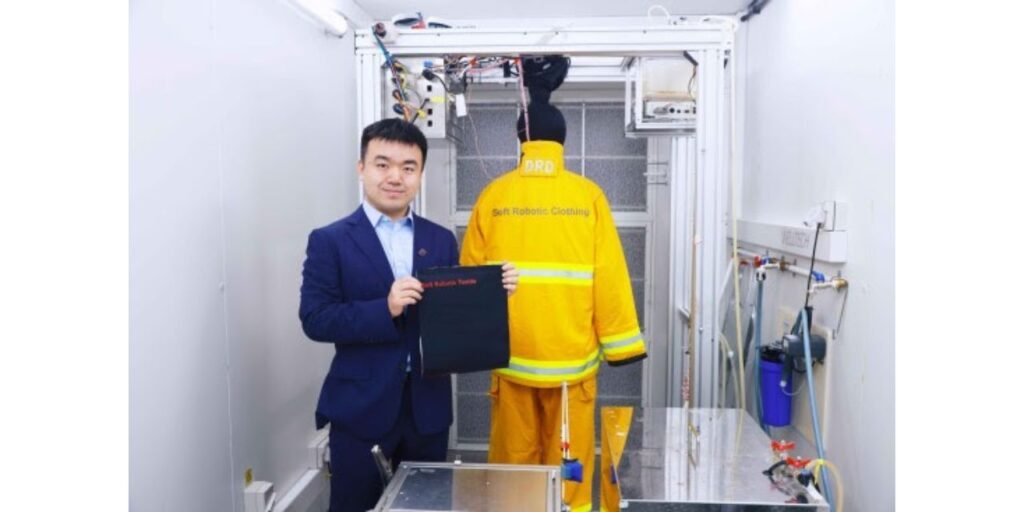
A group headed by Associate Professor Dahua Shou, the Limin Endowment Young Scholar in Advanced Textile Technologies, and Dr. Educator at the Fashion School and PolyU Textiles has created first-of-its-kind
unique soft robotic apparel that is capable of automatically adjust to shifting environmental time frame, therefore making sure that security in warm settings.
August 13, 2024 People are suffering from excessive heat more and more as global warming gets worse. Maintaining thermal comfort becomes especially important for people who operate in high-temperature environments, whether they are outside or indoors. Dr. Dahua SHOU’s team, Limin Associate Professor and Endowed Young Scholar in Advanced Textile Technologies The Hong Kong Polytechnic University (PolyU) School of Fashion & Textiles has created the first-ever breathable, thermally-insulated soft robotic clothes that can automatically adjust to shifting outside temperatures, assisting in ensuring worker security in warm settings. The results of their research have been published in the worldwide Advanced Science is a multidisciplinary publication.
Sustaining a steady body temperature is among the most essential needs for both living and functioning. High temperatures raise the need for energy, which increases heat stress and exacerbates long-term health issues including cardiovascular disease. asthma, diabetes, and mental health problems, as well as raising the risk of infectious illness transfer. The World Health Organization states that, worldwide, there were Between 2000 and 2019, there were over 489,000 heat-related fatalities yearly, with 45% occurring in Asia and 36% in Europe.
For the safety of anyone working in extremely hot conditions, such as firemen who must attend fire scenes and construction workers who spend a lot of time outside, thermal protection gear is a must. But conventional equipment has been scarce. by statically fixed heat resistance, which may cause discomfort and overheating in While its thermal insulation would not provide enough protection in mild to moderate circumstances, events involving fire and other hot conditions. Taking this matter up, Dr. Shou and his team has created robotic soft clothes with intelligence for automated temperature adjustment. Superior thermal insulation in warm climates, providing exceptional personal safety and thermal comfort in a variety of weather conditions.
Their study was motivated by natural biomimicry, such as the pigeons’ primarily structurally based adaptive heat control system. To prevent heat loss to the surroundings, pigeons utilize their feathers to create a layer of air surrounding their skin. They puff up their feathers to trap a lot of heat as the temperature lowers. air, maintaining warmth and boosting thermal resistance.
The team’s protective gear utilizes dynamic adaptive temperature management with soft robotic textile. The human network-patterned exoskeleton-like soft actuators, which contain a low-boiling-point, non-flammable fluid and are non-toxic, were carefully ingrained in the apparel. This mechanism that is thermostimulated changes the fluid from a liquid When the outside temperature rises, becoming a gas, increasing the still air gap and doubling the heat resistance from 0.23 to 0.48 Km2/W by thickening the textile matrix and forcing the soft actuators to expand. Also, the protective apparel may maintain the inside surface
even at 120°C on the outside, temperatures at least 10°C lower than traditional heat-resistant apparel.
This special thermoplastic polyurethane soft robotic textile is robust, soft, and long-lasting. Notably, compared to temperature-responsive clothing, it is significantly more skin-friendly and conforming. incorporates shape-memory alloys and may be adjusted to provide a variety of protective apparel. The soft actuators have undergone extensive testing, and they have not shown any leaks. typical checks for washing. The material’s spaced, porous knitting structure can also lower convective heat transmission by a large amount while keeping moisture breathability high. Not depending on liquid cooling systems or thermoelectric chips to provide heat or cooling conduction, the light-weighted, soft robotic clothing can effectively regulate temperature itself without using any energy.
Wearing bulky firefighting gear can feel quite oppressive, according to Dr. Shou. Firefighters may have almost a pound of perspiration on their boots after leaving a scene and taking off their gear. This has inspired me to create a unique suit that can adjust to different temperatures of the surrounding air while preserving outstanding breathability. Our flexible robotic Clothes can easily transition between various working and living situations, seasons, and climates. circumstances, as well as changes between indoor and outdoor settings, to aid users in experiencing steady thermal comfort even in very hot conditions.
Dr. Shou believes that the breakthrough has a wide range of possible uses in the future, including sustainable textile-based insulation for buildings and construction, outdoor gear, healthcare garments, and activewear that may help save energy. backed by the Hong Kong Research Institute and the Innovation and Technology Commission Dr. Shou and his colleagues at the Institute of Textiles and Apparel have also expanded the thermo- innovative idea to create breathable, inflatable coats and other warm apparel. This kind robot Clothes that is appropriate for chilly settings or abrupt temperature reductions can help individuals who are stuck in the woods in order to keep their body temperature regular.
